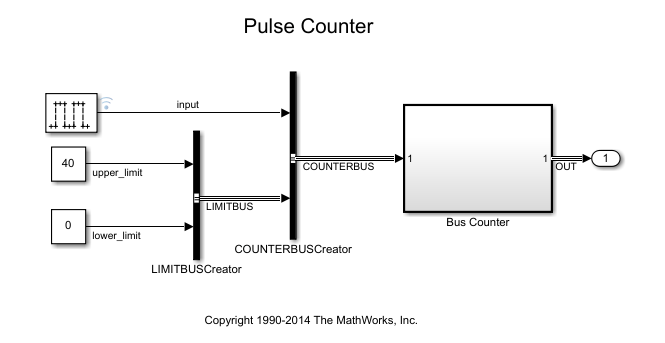getSignalIDsByName
Get signal IDs for signals inside Simulink.sdi.Run object using
signal name
Description
sigIDs = getSignalIDsByName(runObj,name)Simulink.sdi.Run object with the specified name, name.
Examples
You can access signal IDs for signals inside a Simulink.sdi.Run object by specifying the name of the signal for which you want the signal ID. You can use the signal ID to compare signals using the Simulink.sdi.compareSignals function, access the Simulink.sdi.Signal object for the signal using the Simulink.sdi.getSignal function, or delete the signal from the Simulation Data Inspector using the Simulink.sdi.deleteSignal function.
This example shows how to use the getSignalIDsByName function to access a signal using its name or its block path and how to access the signal ID for a signal contained inside a bus.
Create Data in the Simulation Data Inspector
This example uses a model of a pulse counter to create simulation data in the Simulation Data Inspector. The model has two input signals that define the upper and lower limits for the counter, and one input pulse signal with pulses to count. The model uses buses to send data into the Bus Counter subsystem and out of it to an Outport block. The model is configured to log the pulse signal, input, and the output signal, OUT, which is connected to the Outport block.

Simulate the model to create a run that contains the logged data in the Simulation Data Inspector.
out = sim('ex_pulse_counter');Access Signal IDs
Use the Simulation Data Inspector programmatic interface to access the logged data. The Simulink.sdi.Run.getLatest function returns the Simulink.sdi.Run object that corresponds to the most recently created run. You can access the signal IDs for logged signals from the Simulink.sdi.Run object.
countRun = Simulink.sdi.Run.getLatest;
Use the getSignalIDsByName function to access the signal ID for the input signal.
inSigID = getSignalIDsByName(countRun,'input');In a more complicated model, multiple signals might have the same name. In that case, using only the signal name with the getSignalIDsByName function results in an array of signal IDs for all logged signals in the model that use that name. To avoid duplicate results, you can specify the block path and signal name together. Use dots to separate elements of the block path instead of slashes. For example, to access the signal ID for the input signal, you could also specify the name as 'ex_pulse_counter.Pulse Generator.input'.
inSigID = getSignalIDsByName(countRun,'ex_pulse_counter.Pulse Generator.input');Access Signal IDs for Signals Inside Composite Signals
The output logged in the ex_pulse_counter model is a bus signal. You can access the signal ID that corresponds to the top bus signal, OUT, the nested bus, LIMITBUS, and the individual signals in the bus: output, upper_limit, and lower_limit.
To access the signal ID for the top bus, specify the signal name, OUT.
OUTSigID = getSignalIDsByName(countRun,'OUT');To access the signal ID for the nested bus, specify the path to the signal in the bus hierarchy.
LIMITBUSSigID = getSignalIDsByName(countRun,'OUT.LIMITBUS');To access the signal ID for one of the individual signals, specify the path to the signal in the bus hierarchy. You cannot access the signal using only the signal name. The Name property of the Signal object includes the bus hierarchy.
upper_limitSigID = getSignalIDsByName(countRun,'OUT.LIMITBUS.upper_limit');
upper_limitSig = Simulink.sdi.getSignal(upper_limitSigID);
upper_limitSig.Nameans = 'OUT.LIMITBUS.upper_limit'
Input Arguments
Run containing the signals with the signal IDs you want to access, specified as a
Simulink.sdi.Run object.
Name of the signal with the signal ID you want to access, specified as a character vector or string.
A model can use the same signal name for more than one signal. In that case, when
you want to access the signal ID for a specific signal, you can include the block path
for the block that produces the signal in the name argument. For
example, specify name as
'slexAircraftExample.Pilot.Stick' to access the signal ID for the
signal named Stick that is the output of the Pilot
block in the slexAircraftExample model.
To access signals inside composite signals, specify the path to the signal through
the hierarchy of the composite signal. For example, specify name as
'COUNTERBUS.LIMITBUS.lower_limit' to access the signal ID for the
lower_limit signal inside the bus LIMITBUS that
is nested in the bus COUNTERBUS.
Data Types: char | string
Output Arguments
One or more signal IDs for signals with the specified name, returned as a scalar or array.
Version History
Introduced in R2020a
MATLAB Command
You clicked a link that corresponds to this MATLAB command:
Run the command by entering it in the MATLAB Command Window. Web browsers do not support MATLAB commands.
Sélectionner un site web
Choisissez un site web pour accéder au contenu traduit dans votre langue (lorsqu'il est disponible) et voir les événements et les offres locales. D’après votre position, nous vous recommandons de sélectionner la région suivante : .
Vous pouvez également sélectionner un site web dans la liste suivante :
Comment optimiser les performances du site
Pour optimiser les performances du site, sélectionnez la région Chine (en chinois ou en anglais). Les sites de MathWorks pour les autres pays ne sont pas optimisés pour les visites provenant de votre région.
Amériques
- América Latina (Español)
- Canada (English)
- United States (English)
Europe
- Belgium (English)
- Denmark (English)
- Deutschland (Deutsch)
- España (Español)
- Finland (English)
- France (Français)
- Ireland (English)
- Italia (Italiano)
- Luxembourg (English)
- Netherlands (English)
- Norway (English)
- Österreich (Deutsch)
- Portugal (English)
- Sweden (English)
- Switzerland
- United Kingdom (English)